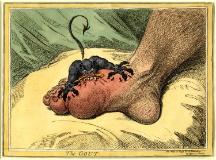Period Band B
Cut/Bite/Stamp: The Power of Print in Eighteenth-Century Britain
Tutor: Richard Johns
Description
Some of the eighteenth century’s most enduring and influential works of art were prints: multiple images that were traded in specialist shops, collected, copied and seen by thousands. This module examines how artists such as William Hogarth, Thomas Rowlandson and James Gillray harnessed the political and economic possibilities of the printed image to engage with the manners and morals of contemporary British society.
Alongside the rise of graphic satire (a term which encompasses some of the most highly charged images in British art) we will also examine the growing demand for ambitious prints after the work of living painters and canonical ‘old masters’ – specialists in portraiture, history painting and landscape, whose work found new meanings and reached a wider, international audience in printed form. Through themed case studies and close, contextual readings, we will explore the dynamic interplay between different forms of visual representation, examining the fluid nature of seemingly stable artistic categories.
The module will consider how artists variously exploited the formal characteristics, immediacy and associations of different printmaking techniques (including etching, engraving, mezzotint, aquatint, and the application of colour), to produce a visual culture that continues to challenge conventional distinctions between ‘polite’ and ‘impolite’, ‘high’ and ‘low’ art.
Objectives
At the end of the module, the students should have acquired:
- a good knowledge of the principal printmakers in Britain, including their techniques and channels of distribution
- the ability to articulate and respond critically and creatively to different art-historical approaches to the subject
- an awareness of the methodological challenges and opportunities associated with the historical study of reproducible graphic art, especially in relation to the recent historiography of visual culture in Britain
- an understanding of key cultural concepts associated with graphic art during the long eighteenth century, including politeness, satire, caricature, connoisseurship and taste
- a critical awareness of how the art of the past continues to inspire political and cultural debate
Preliminary Reading
- Timothy Clayton, The English Print 1688-1802 (1997)
- Diana Donald, The Age of Caricature: Satirical Prints in the Reign of George III (1997)
- Mark Hallett, The Spectacle of Difference (1999)
- Richard Godfrey (ed.), James Gillray: The Art of Caricature (2001)
- Ronald Paulson, Hogarth, 3 vols (1991–93)

Module code HOA00054I
